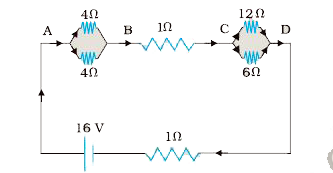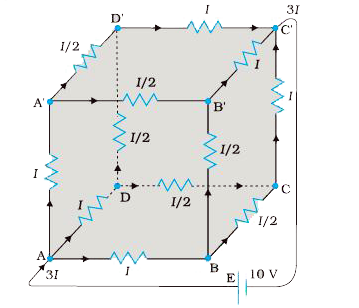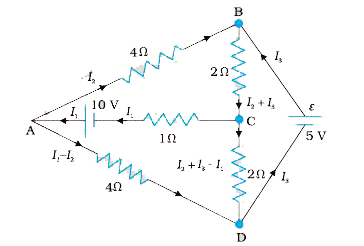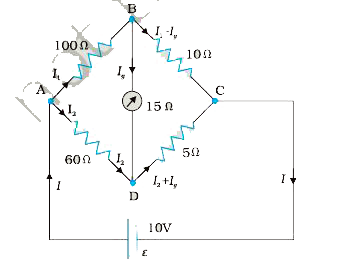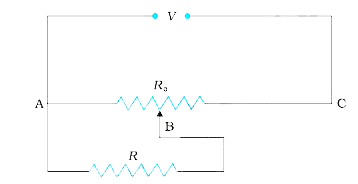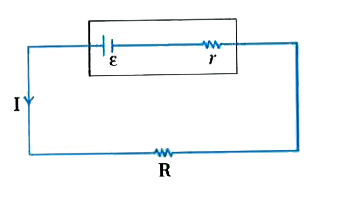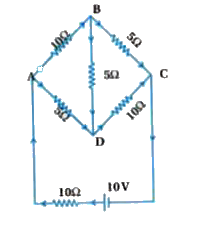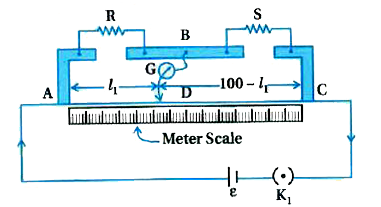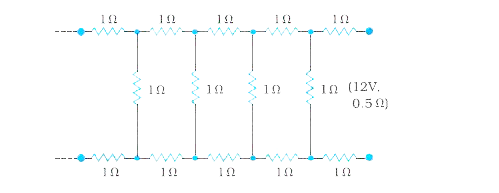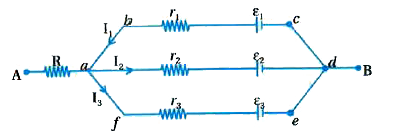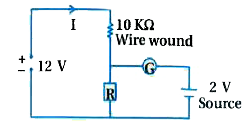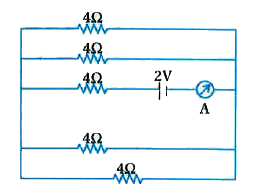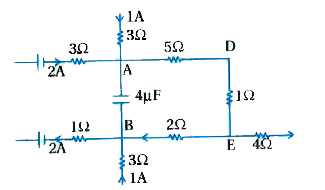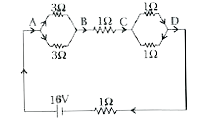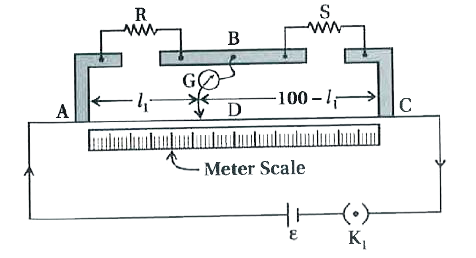SECTION [B] (NUMERICAL FROM TEXTUAL EXERCISE) from KUMAR PRAKASHAN KENDRA PHYSICS (GUJRATI ENGLISH) CURRENT ELECTRICITY for Class 12
| Class 12 | PHYSICS |
| Chapter | CURRENT ELECTRICITY |
| KUMAR PRAKASHAN KENDRA PHYSICS (GUJRATI ENGLISH) | SECTION [B] (NUMERICAL FROM TEXTUAL EXERCISE) |
| Medium | English |
| Academic Year | 2023-2024 |
Question 1
(a) Esttimate the average drift speed of conduction electrons in a copper wite of cross-secttonal area 1.0×10−7m2 carrying a current of 1.5A. Assume the each copper atom contrbutes roughly one conduction electron. The density of copper is 9.0×103kg/m3, and its atomic mass is 63.5u. (b) Compare the drift speed obyained above with, (1) thermal speeds of copper atoms at ordinary temperaturtes. (ii) speed of propagation of electric field along the conductor which causes the drift motion. View SolutionQuestion 7
An electric toaster uses nichrome for its heating element. When a negligibly small current passes through it, its resistance at room temperature (27.0∘C) is found to be 75.3 Ω . When the toaster is connected to a 230 V supply, the current settles, after a few seconds, to a steady value of 2.68 A. What is the steady temperature of the nichrome element ? The temperature coefficient of resistance of nichrome averaged over the temperature range involved , is 1.70×10−4∘C−1. View SolutionQuestion 20
(a) Three resistors 2Ω4Ωand5Ω are combined in parallel. What is the total resistance of the combination ?
(b) If the combination is connected to a bettery of emf 20 V and neglibible internal resistance, determine the current through each resistor, and the total current drawn from the battery. View SolutionQuestion 24
An electric toaster uses nichrome for its heating element. When a negllgibly small current pases through it, its resistance at room temperature (27.0∘C) is found to be 75.3Ω. When the toaster is connected to a 230 V supply, the current settles, after a few seconds, to a steady value of 2.68A. What is the steady temperature of the nichrome element ? The temperature coefficient of resistance of nichrome averaged over the temperature range involved is 1.70×10−4∘C−1. View SolutionQuestion 32
The earth's surface has a negative surface charge density of 10−9Cm−2. The potential difference of 400 kV between the top of the atmosphere and the surface results (due to the low conductivity of the lower atmosphere) in a current of only 1800 A over the entire globe. If there were no mechanism of sustaining atmospheric electric field, how much time (roughly) would be required to neutralise the earth's surface? (This never happens in practice because there is a mechanism to replenish electric charges. namely tghe coontainual thunderstorms and lighting in different parts of the globe). (Radius of earth =6.37×106m.) View SolutionQuestion 33
(a) Six lead-acid type of secondary cells each of emf 2.0V and internal resistacne 0.015Ω are joined in series to provide a supply to a resistance of 8.5Ω. What are the current drawn from the suply and its terminal voltage ?
(b) A secondary cell after long use has an emf of 1.9V and a large internal resistance of 380Ω. What maximum current can be drawn from the cell? Could the cell drive tghe starting motor of a car ? View SolutionQuestion 34
Two wires of equal length, one of aluminium and the other of copper have the same resistance. Which of the two wires is lighter ? Hence explain why aluminium wires are preferred for overhead power cables. (ρAl=2.63×10−8Ωm,ρCu=1.72×10−8Ω m, Relative density of Al = 2.7 , of Cu = 8.9 )View SolutionQuestion 40
Choose the correct alternative:
(a) Alloys of metals usually have (greater/less) resistivity than that of their constituent metals.
(b) Alloys usually have much (lower/higher) temperature coefficients of resistance than pure metals.
(c ) The resisitivity of the alloy manganin is nearly independent of/increases rapidly with increase of temperature.
(d) The resistivity of a typical insulator (e.g., amber) is greater than that of a metal by a factor of the order of (1022/1023). View SolutionQuestion 41
Choose the correct alternative:
(a) Alloys of metals usually have (greater/less) resistivity than that of their constituent metals.
(b) Alloys usually have much (lower/higher) temperature coefficients of resistance than pure metals.
(c ) The resisitivity of the alloy manganin is nearly independent of/increases rapidly with increase of temperature.
(d) The resistivity of a typical insulator (e.g., amber) is greater than that of a metal by a factor of the order of (1022/1023). View SolutionQuestion 42
Choose the correct alternative:
(a) Alloys of metals usually have (greater/less) resistivity than that of their constituent metals.
(b) Alloys usually have much (lower/higher) temperature coefficients of resistance than pure metals.
(c ) The resisitivity of the alloy manganin is nearly independent of/increases rapidly with increase of temperature.
(d) The resistivity of a typical insulator (e.g., amber) is greater than that of a metal by a factor of the order of (1022/1023). View SolutionQuestion 43
Choose the correct alternative:
(a) Alloys of metals usually have (greater/less) resistivity than that of their constituent metals.
(b) Alloys usually have much (lower/higher) temperature coefficients of resistance than pure metals.
(c ) The resisitivity of the alloy manganin is nearly independent of/increases rapidly with increase of temperature.
(d) The resistivity of a typical insulator (e.g., amber) is greater than that of a metal by a factor of the order of (1022/1023). View SolutionQuestion 44
(a) Given n resistores each of resistance R. how will you combine them to get the (i) maximum (ii) minimum effective resistance?
(b) Given the resistances of 1Ω,2Ω,3Ω. how will be combine them to get an equivalent resistance of (i)(11/3)Ω(ii)(11/5)Ω,(iii)6Ω,(iv)(6/11)Ω ?
(c ) Determine the equivalent resistance of networks shown in
 View Solution
View SolutionQuestion 45
(a) Given n resistores each of resistance R. how will you combine them to get the (i) maximum (ii) minimum effective resistance?
(b) Given the resistances of 1Ω,2Ω,3Ω. how will be combine them to get an equivalent resistance of (i)(11/3)Ω(ii)(11/5)Ω,(iii)6Ω,(iv)(6/11)Ω ?
(c ) Determine the equivalent resistance of networks shown in
 View Solution
View SolutionQuestion 48
Figure shows a potentiometer with a cell of 2.0 V and internal resistance 0.40 Ω maintaining a potential drop across the resistor wire AB. A standard cell which maintains a constant emfof 1.02 V (for very moderate currents upto a few mA) gives a balance point at 67.3 cmlength of the wire. To ensure very low currents drawn from the standard cell, a very high resistance of 600 kΩ is put in series with it, which is shorted close to the balance point. The standard cell is then replaced bya cell of unknown emfe and the balance point found similarly, turns out to be at 82.3 cm length of the wire.

(a) What is the value ε ?
(b) What purpose does the high resistance of 600 KΩ have ?
(c) Is the balance point affected by this high resistance ?
(d) Would the method work in the above situation if the driver cell of the potentiometer had an emf of 1.0V instead of 2.0 V ?
(e) Would the circuit work well for determining an extremely small emf, say of the order of a few mV (such as the typical emf of a thermocouple) ? If not, how will you modify the circuit ?
(f) Can we use above circuit to measure very small emf of the order of mV. (For example, emf obtained in thermocouple) ? If not, then what change would you make ? View SolutionQuestion 49
show a 2.0V potentiometer used for the determination of internal resistance of a 1.5V cell. The balance point of the cell in open circuit is 76.3 cm. When a resistor of 9.5Ω is used in the external circuit of the cell, the balance point shifts to 64.8cm length of the potentiometer wire. Determine the internal resistance of the cell.
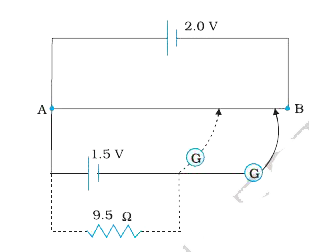 View Solution
View SolutionQuestion 51
Two materials have the value of α1andα2 as 6×10−4(∘C)−1and−5×10−4(∘C)−1
respectively. The resistivity of the first material ρ20=2×20−8Ω. A new material is made by combining the above two materials. the resistivity does not change with temperature . The resistivity ρ20 of the second material is .... Considering the reference temperature as 20∘C assume that the resistivity of the new material is equal to the sum of the resistivity of its component materials. View SolutionQuestion 54
200 Ω resistor is connected in one of the gaps of the meter bridge. Series combination of X Ω and 50 Ω resistors is connected in the second gap. Here unknown resistance X Ω is kept in a heat bath at a certain temperature. The unknown resistance and its temperature is....... and....... respectively if the balance point is obtained at 50 cm. The total length of the wire of the meter bridge is equal to 1 meter. The resistance of the unknown resistance at 0 ∘C temperature is equal to 100 Ω.α=0.5×10−3∘C−1 for the material of the X Ω resistors. View SolutionQuestion 55
An n-type semiconductors has 4×10−3 m width, 25×10−5 m thickness and 6×10−2 m length. 4.8 mA current is flowing through it. Here voltage is applied parallel to the length of the semiconductor. Calculate the current density. The density of the free electron is equal to 1022m−3 .What will be the time taken by the electron across the length of the semiconductor ? View SolutionQuestion 63
One copper wire having resistivity 1.7 ×10−8Ω, density 8.9×103kgm−3, atomic weight 63.5 g mol−1 , length 0.1 m and cross-sectional area 10−6m2carries 1 A electric current. Find (i) potential difference across the wire (ii) drift velocity of free electron. (Avogadro number = 6.02×1023 mol−1 and valency of copper - 1 View SolutionQuestion 64
One copper wire having resistivity 1.7 ×10−8Ω, density 8.9×103kgm−3, atomic weight 63.5 g mol−1 , length 0.2 m and cross-sectional area 10−6m2carries 2 A electric current. Find (i) potential difference across the wire. (ii) drift velocity of free electron . (Avogadro number = 6.02×1023 mol−1 and valency of copper = 1 ) View SolutionQuestion 67
Resistance of platinum wire in one platinum resistance thermometer at ice point and at steam point are respectively 10 Ωand10.78Ω. When this thermometer is kept in one heat bath, its resistance is found to be 10.123 Ω. Find temperature of this heat bath in degree Fahrenheit (∘F). View Solution
All Exercises from KUMAR PRAKASHAN KENDRA PHYSICS (GUJRATI ENGLISH) Class 12 PHYSICS CURRENT ELECTRICITY
- SECTION [A] TRY YOURSELF
- SECTION [A] QUESTIONS - ANSWERS (INTRODUCTION )
- SECTION [B] (NUMERICAL FROM .DARPAN. BASED ON TEXTBOOK)
- SECTION [B] (NUMERICAL FROM TEXTUAL EXERCISE)
- SECTION [B] (NUMERICAL)
- SECTION [B] NUMERICALS (NUMERICAL FROM TEXTUAL ILLUSTRATIONS)
- SECTION C (LONG ANSWER TYPE QUESTIONS )
- SECTION C (MULTIPLE CHOICE QUESTIONS (MORE THAN ONE OPTIONS))
- SECTION C (SHORT ANSWER TYPE QUESTIONS )
- SECTION C (VERY SHORT ANSWER TYPE QUESTIONS)
- SECTION C NCERT EXEMPLAR SOLUTION (MULTIPLE CHOICE QUESTIONS (MCQS))
- SECTION [D] MULTIPLE CHOICE QUESTIONS (MCQS) (MCQS ASKED IN AIIMS)
- SECTION [D] MULTIPLE CHOICE QUESTIONS (MCQS) (MCQS ASKED IN BOARD EXAM AND GUJCET)
- SECTION [D] MULTIPLE CHOICE QUESTIONS (MCQS) (MCQS ASKED IN CBSE-PMT, AIPMT, NEET)
- SECTION [D] MULTIPLE CHOICE QUESTIONS (MCQS) (MCQS ASKED IN COMPETITIVE EXAMS)
- SECTION [D] MULTIPLE CHOICE QUESTIONS (MCQS) (MCQS FROM .DARPAN. BASED ON TEXTBOOK)
